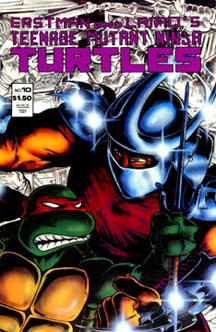Fans of the first TMNT movie will recognize these next three issues in Mirage “Teenage Mutant Ninja Turtles” Volume 1 — the “Leonardo” one-issue micro-series and Issues 10 and 11 (1986-87) – as the basis for the middle section of the 1990 TMNT movie. It’s also the trilogy of issues where Eastman and Laird’s “TMNT” grows up.
Gone is any trace that “TMNT” is a joke or parody (Issue 1), and the writers/artists also seem to have gotten the wildly imaginative world-building (Issues 4-9) out of their system. Now it’s time to get down to business and tell a gritty down-to-Earth TMNT story.
“Leonardo” one-shot
I mentioned in my last post that among the four Turtle-based one-shots, only “Michaelangelo” is effectively character-oriented. But a case could be made for “Leonardo” (“What Goes Around … Comes Around!”), which takes place one year after his brother’s Christmas tale.

“Teenage Mutant Ninja Turtles” “Leonardo” one-shot and Issues 10-11 (1986-87)
Titles: “What Goes Around … Comes Around!” (“Leonardo”), “Silent Partner” (No. 10), “True Stories” (No. 11)
Writers: Kevin Eastman and Peter Laird
Pencils: Kevin Eastman and Peter Laird
Inks: Kevin Eastman, Peter Laird, Steve Bissette, Michael Dooney, Ryan Brown
Although Leo doesn’t speak a word the entire issue up until the last panel (“He’s … back … The … Shredder!”), one could argue that we do get a window into Leo’s character as he fights Foot soldiers on page after page; of course, Raph gets this role – with a lot more quips – in the movie. (At the bottom of each page, in a beautiful artistic touch, Raph, Mike, Don, April and Splinter go through warm yuletide traditions like decorating the tree, singing carols and making dinner.) Leo views himself as a protector of his family, and when he is sent flying through April’s apartment window, he feels like he failed.
Issue 10
Still, “Leonardo” isn’t merely a side story where we get under Leo’s shell. I wonder if E&L decided to present it that way in order to maximize the shock value when the Shredder (last seen blown to pieces in Issue 1) shows up. The action continues directly into the thrilling Issue 10 (“Silent Partner”), where the gang (plus hero of the day Casey Jones) escapes the Shredder and the Foot soldiers – and the fire they started in the Second Time Around shop with a bomb — via a hole in an old walk-in freezer.
Issue 11
Issue 11 (“True Stories”) is the real masterpiece, though, as the gang settles in at Casey’s grandma’s beat-up old farm outside of Northampton, Mass. As April writes in her journal, although they had fled to the farm to heal up from the fight, everyone drifts apart to wallow in their first major defeat. April writes: “We all feel so much pain and confusion … The cure hangs plainly … But who will be the first to reach out? … We need each other!” April’s journal provides a warm motherly touch to the proceedings.

Raph’s on edge and Mike’s uncharacteristically angry, although Don seems to have found his place in life, since the farmhouse is an ideal fixer-upper. Continuing his emotional journey from his one-shot, Leonardo fails to kill a deer and hangs his head in shame and misery.
As April notes: “The battle tore him up terribly in body and mind. Physically he has healed incredibly well, but mentally … I’m afraid he has a lot of catching up.” When April falls through the ice and Leo saves her, everyone snaps back to reality. April writes, and Splinter reiterates in a fireside chat to his sons: “Life is good, and life goes on.” (Unlike in the movie, Splinter has not been kidnapped by the Foot, so it’s the actual Splinter, not an apparition.)
Issue 11 reminds me of my family’s lake cabin in Minnesota, and it seems like the perfect story to read on a cool summer day on the deck. I don’t know if the farmhouse is based on something from Eastman or Laird’s family, but I wouldn’t be surprised. I get a sense that they wrote “True Stories” straight from the heart.
Although this trilogy of issues leaves a huge unanswered question – How the heck is the Shredder alive?! – that won’t be addressed until Issue 19, it’s nonetheless a satisfying package. It also marks the end of the three-year, 16-issue (1-11 plus “Fugitoid” and the four Turtle one-shots) journey where both Eastman and Laird had a hand in writing and drawing everything.
At this point, all the requisite pieces had been put down in comic form for screenwriters Todd W. Langen and Bobby Herbeck to pick up and re-assemble into the 1990 “TMNT” movie. In 1987, Eastman and Laird began the process of managing an empire, too, starting with the cartoon (later in 1987) and toy line (1988), and they started handing off more Mirage writing and art to other folks.
Thankfully, this wasn’t the end of E&L’s contribution to the saga, but even just these 16 issues would’ve left quite a legacy.

